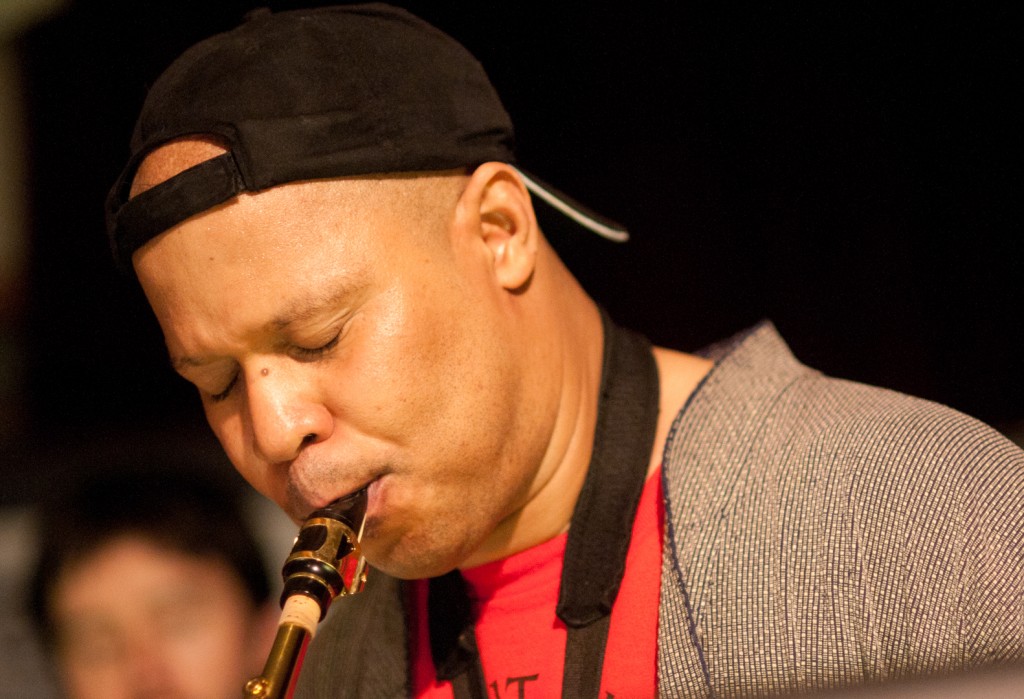
Talea hits the Newport Jazz Festival this Sunday, August 4th, with a brand new piece by legendary jazz saxophonist, Steve Coleman. Checkout Anthony Cheung’s post about working with Steve on his new piece for Talea.
After rehearsal yesterday, I had a chance to sit down with Steve Coleman and talk about his approach and interests. With a career spanning over three decades, Steve is one of a handful of truly influential musicians of our time. His music and concepts, and the musical community that emerged around himself and other like-minded musicians in Brooklyn in the 1980s, led to the emergence of the M-Base movement, the effects of which are still being felt in many players of subsequent generations. Indeed, pianist and composer Vijay Iyer has remarked, “it’s hard to overstate Steve’s influence. He’s affected more than one generation, as much as anyone since John Coltrane.”
After approaching Steve with the idea of doing a project together, he responded with an invitation to play at the Newport Jazz Festival this year. Though he was originally asked to do something with fellow jazz musicians with whom he had previously no contact, Steve insisted on bringing Talea into the fold, after a period of checking out the ensemble’s work and seeing the possibilities of an interesting collaboration.
His new piece, titled “Synovial Joints,” reflects a continuing theme in his work, a preoccupation with systems of the body and the interconnected rhythms they share. But far from mapping these connective tissues literally, they provide a metaphor for the way the music is constructed, the way rhythm grooves – and Steve’s music always grooves hard – overlap and transform. He talks about how shared rhythmic elements between different patterns are like the musical joints that make different independent limbs work together. And the discussion goes beyond musical ligaments, into spheres of influence and overlapping orbits of experience. Can we, as an ensemble that specializes in mostly notated music, capture the essence of what he’s doing with an essentially extemporized idiom? Rehearsals make that point clear: the ensemble responds with alacrity to his modifications and suggestions, both verbal and notated, after a period of adjusting to his way of working. Capturing what Steve is trying to do groove-wise, though seemingly clear on paper, takes longer to grasp, and in the end we are all taken with the absolute mastery with which he communicates his intentions.
He mentions meeting Per Nørgård and taking a liking to his music and ideas immediately, a connection that makes way too much sense: Nørgård, a Danish individualist who also works with the interweaving of rhythmic and melodic cycles, is similarly interested in musical metaphysics, as if the proportions of musical material can lead toward a higher plane of consciousness.
The discussion turns to mentorship, and some of Steve’s early on included the great Chicago-based tenor saxophonist Von Freeman, and later Sam Rivers and Thad Jones, in whose big bands he played for a while. And Steve has continued that tradition admirably, working with younger players and serving as a model of generosity with his own ideas. For the project with Talea, he has brought in two younger players with whom he often collaborates, trumpeter Jonathan Finlayson, a member of Steve’s longstanding group Five Elements since 2000, and drummer Dafnis Prieto, a recent recipient of a MacArthur Fellowship. And another young musician, the Swiss-born saxophonist Maria Grand, is on hand to assist with the score and play clave patterns. It is this coming together of talent from different yet overlapping musical orbits that has been the lifeblood of Steve Coleman’s music, and Talea is thrilled to be a part of it.
-Anthony Cheung
Artistic Director, Talea Ensemble
